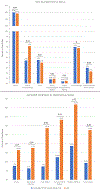Characterization of Individuals With Apparent Resistant Hypertension Using Contemporary Guidelines: Insights From CV-QUIC
- PMID: 37357771
- PMCID: PMC10524942
- DOI: 10.1161/HYPERTENSIONAHA.123.20894
Characterization of Individuals With Apparent Resistant Hypertension Using Contemporary Guidelines: Insights From CV-QUIC
Abstract
Background: Apparent resistant hypertension (aRH) carries excess cardiovascular risk beyond nonresistant forms of hypertension; however, our understanding of this at-risk population, as defined by current US practice guidelines, is limited. Accordingly, we sought to evaluate the prevalence, clinical characteristics, and pharmacotherapeutic patterns of patients with aRH using contemporary blood pressure guidance.
Methods: We classified patients at 3 large healthcare systems by hypertensive status using contemporary hypertension guidelines. We subsequently described the demographic and clinical characteristics of patients with aRH and compared these factors among hypertensive patients without aRH and between those with controlled and uncontrolled aRH.
Results: A total of 2 420 468 patients were analyzed, of whom 1 343 489 (55.6%) were hypertensive according to contemporary guidelines. Among hypertensive patients, 11 992 (8.5%) met criteria for aRH, with nearly all assessed comorbid conditions, particularly diabetes and heart failure, being more common in those with aRH. When compared with patients with uncontrolled aRH, those with controlled aRH were more frequently prescribed a beta-blocker, diuretic, and nitrate, with the largest standardized difference observed for a mineralocorticoid receptor antagonist (35.4% versus 10.4%, Cohen D 0.62). Consistent findings were noted in sensitivity analyses using the blood pressure threshold of 140/90 mm Hg.
Conclusions: In an analysis of over 2.4 million individuals, a lower prevalence of aRH was observed than previously reported (12%-15%), but with a high burden of comorbidities. Identification of differences in pharmacotherapy between patients with controlled and uncontrolled aRH, particularly lower rates of mineralocorticoid receptor antagonist use, help define potential opportunities to improve care and lower cardiovascular risk.
Keywords: angiotensin-converting enzyme; blood pressure; electronic health record; epidemiology; hypertension.
Conflict of interest statement
Figures



Comment in
-
Characteristics of Adults With Apparent Treatment Resistant Hypertension: Six Factors Impacting Prevalence-Editorial Commentary.Hypertension. 2023 Sep;80(9):1856-1859. doi: 10.1161/HYPERTENSIONAHA.123.21494. Epub 2023 Aug 16. Hypertension. 2023. PMID: 37585541 No abstract available.
References
Publication types
MeSH terms
Substances
Grants and funding
LinkOut - more resources
Full Text Sources
Medical
Miscellaneous

